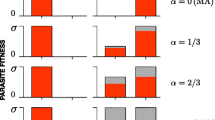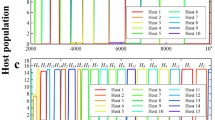Abstract
Many mutualisms involve reciprocal exploitation, such that each species in a mutualism is a consumer of a resource provided by the other. Frequently, such mutualisms are reformed each generation, and where they involve close physiological contact, such as between mycorrhizal fungi and plants, they can be considered as examples of reciprocal parasitism. Here we place such interactions in the framework of the Prisoner’s Dilemma, and examine the conditions for the spread of mutualism using a population genetics model analogous to that used for understanding the genetic and numerical dynamics of host-parasite interactions. Genetic variants within each of two species determine whether the interaction is mutualistic or selfish, the latter being represented by resistance to being exploited or parasitized. We assume that there are fitness costs to resistance which are present even in the absence of the interaction. Just as in host-parasite interactions, we examine the effect of assuming that encounter rates between potential mutualists (and therefore entry into the Prisoner’s Dilemma ‘game’) depend on the density and frequency of the different types interacting individuals. These elements of ecological realism greatly facilitate the evolution of mutualism even in the absence of spatial structure or iterative encounters. Moreover, stable genetic polymorphisms for resistant (selfish) and susceptible (mutualistic) alleles can be maintained, something that is not possible with the classical Prisoner’s Dilemma formulation. The sensitivity of the outcomes to levels of density-dependence and mortality rate suggests environmental as well as genetic processes are likely to be important in determining directions in this pathway to mutualism.




Similar content being viewed by others
References
Aguilar-Trigueros CA, Powell JR, Anderson IC, Antonovics J, Rillig MC (2014) Ecological understanding of root-infecting fungi using trait-based approaches. Trends Plant Sci 19:432–438
Antonovics J, Thrall PH (1994) The cost of resistance and the maintenance of genetic polymorphism in host-pathogen systems. Proc R Soc Lond B 257:105–110
Antonovics J, Iwasa Y, Hassell MP (1995) A generalized model of parasitoid, venereal, and vector-based transmission processes. Am Nat 145:661–675
Baker C, Antonovics J (2012) Evolutionary determinants of genetic variation in susceptibility to infectious diseases in humans. Plos One 7:e29089
Biere A, Antonovics J (1996) Sex-specific costs of resistance to the fungal pathogen Ustilago violacea (Microbotryum violaceum) in Silene alba. Evolution 50:1098–1110
Boots M, Haraguchi Y (1999) The evolution of costly resistance in host-parasite systems. Am Nat 153:359–370
Boots M, White A, Best A, Bowers R (2014) How specificity and epidemiology drive the coevolution of static trait diversity in hosts and parasites. Evolution 68:1594–1606
Bowers RG, Boots M, Begon M (1994) Life-history trade-offs and the evolution of pathogen resistance: competition between host strains. Proc R Soc Lond B 257:247–253
Boyd R, Richerson PJ (1992) Punishment allows the evolution of cooperation (or anything else) in sizeable groups. Ethol Sociobiol 13:171–195
Bronstein JL (1994) Conditional outcomes in mutualistic interactions. Trends Ecol Evol 9:214–217
Bronstein JL (2001) The exploitation of mutualisms. Ecol Lett 4:277–287
Chaverri P, Samuels GJ (2013) Evolution of habitat preference and nutrition mode in a cosmopolitan fungal genus with evidence of interkingdom host jumps and major shifts in ecology. Evolution 67:2823–2837
Connor RC (1995) The benefits of mutualism: a conceptual framework. Biol Rev 70:427–457
Darwin C (1859) On the origin of species by means of natural selection. John Murray, London
De Mazancourt C, Schwartz MW (2010) A resource ratio theory of competition. Ecol Lett 13:349–359
Doebeli M, Knowlton N (1998) The evolution of interspecific mutualisms. Proc Natl Acad Sci USA 95:8676–8680
Dreber A, Rand DG, Fudenberg D, Nowak MA (2008) Winners don’t punish. Nature 452:348–351
Egger KN (2006) The surprising diversity of ascomycetous mycorrhizas. New Phytol 170:421–423
Fehr E, Gächter S (2002) Altruistic punishment in humans. Nature 415:137–140
Fenton A, Antonovics J, Brockhurst MA (2009) Inverse gene-for-gene infection genetics and coevolutionary dynamics. Am Nat 174:E230–E242
Genkai-Kato M, Yamamura N (1999) Evolution of mutualistic symbiosis without vertical transmission. Theor Popul Biol 55:309–323
Gimelfarb A (1988) Processes of pair formation leading to assortative mating in biological populations: encounter-mating model. Am Nat 131:865–884
Gorton AJ, Heath KD, Pilet-Nayel ML, Baranger A, Stinchcombe JR (2012) Mapping the genetic basis of symbiotic variation in legume-rhizobium interactions in Medicago trunculata. G3: Genes Genomes Genet 2:1291–1303
Hacskaylo E (1972) Mycorrhiza: the ultimate in reciprocal parasitism. BioScience 22:577–583
Hadeler KP (1989) Pair formation in age structured populations. Acta Appl Math 14:91–102
Heath KD, Tiffin P (2007) Context dependence in the coevolution of plant and rhizobial mutualists. Proc R Soc Lond B 274:1905–1912
Heil M, Gonzalez-Teuber M, Clement LW, Kautz S, Verhaagh M, Bueno JCS (2009) Divergent investment strategies of Acacia myrmecophytes and the coexistence of mutualists and exploiters. Proc Natl Acad Sci USA 106:18091–18096
Heinrich B, Raven PH (1972) Energetics and pollination ecology. Science 176:597–602
Herre EA, Knowlton N, Mueller U, Rehner SA (1999) The evolution of mutualisms: exploring the paths between conflict and cooperation. Trends Ecol Evol 14:49–53
Holland JN, DeAngelis DL (2010) A consumer-resource approach to density-dependent population dynamics of mutualism. Ecology 91:1286–1295
Hom EFY, Murray AW (2014) Niche engineering demonstrates a latent capacity for fungal-algal mutualism. Science 345:94–98
Irwin R, Bronstein JL, Manson JS, Richardson LE (2010) Nectar-robbing: ecological and evolutionary perspectives. Ann Rev Ecol Evol Syst 41:271–292
Jansen VAA, van Baalen M (2006) Altruism through beard chromodynamics. Nature 440:663–666
Janzen DH (1966) Coevolution of mutualism between ants and acacias in Central America. Evolution 20:249–275
Kiers ET, Palmer TM, Ives AR, Bruno JF, Bronstein JL (2010) Mutualisms in a changing world: an evolutionary perspective. Ecol Lett 13:1459–1474
Kostitzin VA (1935) Symbiosis, parasitism, and evolution. Reprinted in Scudo FM, Ziegler JR (1978) The golden age of theoretical ecology, 1923–1940. Lect Notes Biomath 22:369–408
Law R, Dieckmann U (1998) Symbiosis through exploitation and the merger of lineages in evolution. Proc R Soc Lond B 265:1245–1253
Lewis HM, Dumbrell AJ (2013) Evolutionary games of cooperation: insights through integration of theory and data. Ecol Complex. doi:10.1016/j.ecocom.2013.02.007
Maynard Smith J (1979) Game theory and the evolution of behaviour. Proc R Soc Lond B 205:475–488
Merckx V, Freudenstein JV (2010) Evolution of mycoheterotrophy in plants: a phylogenetic perspective. New Phytol 185:605–609
Noë R, van Hoof J, Hammerstein P (2001) Economics in nature. Social dilemmas, mate choice and biological markets. Cambridge University Press, Cambridge
Nowak MA (2006) Five rules for the evolution of co-operation. Science 314:1560–1563
Pande S, Merker H, Bohl K, Reichelt M, Schuster S, de Figueiredo LF, Kaleta C, Kost C (2014) Fitness and stability of obligate cross-feeding interactions that emerge upon gene loss in bacteria. ISME J 8:953–962
Ronsheim M (1997) Distance-dependent performance of asexual progeny in Allium vineale. Am J Bot 84:1279–1284
Sachs JL, Simms EL (2008) The origins of uncooperative rhizobia. Oikos 117:961–966
Sachs JL, Skophammer RG, Regus JU (2011) Evolutionary transitions in bacterial symbiosis. Proc Natl Acad Sci USA 108(Suppl. 2):10800–10807
Sasaki A (2000) Host-parasite coevolution in a multilocus gene-for-gene system. Proc R Soc Lond B 257:2183–2188
Scheuring I (2005) The iterated continuous Prisoner’s Dilemma game cannot explain the evolution of interspecific mutualism in unstructured populations. J Theor Biol 232:99–104
Soetaert K, Petzoldt T, Setzer RW (2010) Solving differential equations in R: package deSolve. J Stat Softw 33:1–25
Tan J, Zuniga C, Zengler K (2015) Unraveling interactions in microbial communities—from co-cultures to microbiomes. J Microbiol 53:295–305
Tanouchi Y, Smith RP, You L (2012) Engineering microbial systems to explore ecological and evolutionary dynamics. Curr Opin Biotech 23:791–797
Tedersoo L, May TW, Smith ME (2010) Ectomycorrhizal lifestyle in fungi: global diversity, distribution, and evolution of phylogenetic lineages. Mycorrhiza 20:217–263
Tschirren B, Andersson M, Scherman K, Westerdahl H, Raberg L (2012) Contrasting patterns of diversity and population differentiation at the innate immunity gene toll-like receptor 2 (TLR2) in two sympatric rodent species. Evolution 66:720–731
van Baalen M, Jansen AA (2001) Dangerous liaisons: the ecology of private interest and public good. Oikos 95:211–224
Veiga RSL, Faccio A, Genre A, Pieterse CM, Bonfante P, van der Heiden MGA (2013) Arbuscular mycorrhizal fungi reduce growth and infect roots of the non-host plant Arabidopsis thaliana. Plant Cell Environ 36:1926–1937
Veldre V, Abarenkov K, Bahram M, Martos F, Selosse M, Tamm H, Koljalg U, Tedersoo L (2013) Evolution of nutritional modes of Ceratobasidiaceae (Cantharellales, Basidiomycota) as revealed from publicly available ITS sequences. Fungal Ecol 6:256–268
Vila-Aiub MM, Neve P, Roux F (2011) A unified approach to the estimation and interpretation of resistance costs in plants. Heredity 107:386–394
Wang Z, Wu M (2014) Phylogenomic reconstruction indicates mitochondrial ancestor was an energy parasite. Plos One 9:e11685
Webster JP, Woolhouse MEJ (1999) Cost of resistance: relationship between reduced fertility and increased resistance in a snail-schistosome host-parasite system. Proc R Soc Lond B 266:391–396
West SA, El Mouden C, Gardner A (2011) Sixteen common misconceptions about the evolution of co-operation in humans. Evol Hum Behav 32:231–262
Wilkinson DM (1997) The role of seed dispersal in the evolution of mycorrhizae. Oikos 78:394–396
Acknowledgments
J.A. is grateful for support from the Humboldt Foundation and for NSF Grant DEB-1115899 as part of the joint NSF-NIH Ecology of Infectious Disease program.
Author information
Authors and Affiliations
Corresponding author
Electronic supplementary material
Below is the link to the electronic supplementary material.
Rights and permissions
About this article
Cite this article
Antonovics, J., Bergmann, J., Hempel, S. et al. The evolution of mutualism from reciprocal parasitism: more ecological clothes for the Prisoner’s Dilemma. Evol Ecol 29, 627–641 (2015). https://doi.org/10.1007/s10682-015-9775-6
Received:
Accepted:
Published:
Issue Date:
DOI: https://doi.org/10.1007/s10682-015-9775-6




